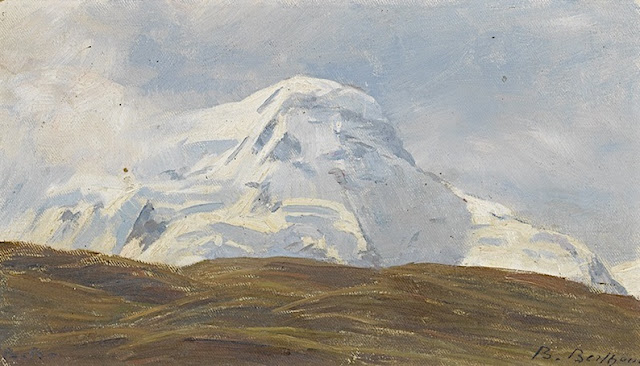PAUL HENRY (1877-1958)
Mount Errigal (751m - 2, 464 ft)
Ireland
The mountain
Mount Errigal (751m - 2, 464 ft) called in Irish An Earagail, possibly meaning "oratory" is a mountain near Gweedore in County Donegal, Ireland. It is the tallest peak of the Derryveagh Mountains, the tallest peak in County Donegal, and the 76th tallest peak in Ireland. Errigal is also the most southern, steepest and highest of the mountain chain, called the "Seven Sisters" by locals. The Seven Sisters includes Muckish, Crocknalaragagh, Aghla Beg, Ardloughnabrackbaddy, Aghla More, Mackoght and Errigal. The nearest peak is Mackoght, which is also known as Little Errigal or Wee Errigal (Irish: an Earagail Bheag). Errigal is well known for the pinkish glow of its quartzite in the setting sun. Another noted quality is the ever-changing shape of the mountain depending on what direction you view it from. Errigal was voted 'Ireland's Most Iconic Mountain' by Walking & Hiking Ireland in 2009.Climbing
The mountain is most often climbed from the carpark off the R251 road. The route initially starts off by crossing heavily eroded and boggy land towards a visible track through the shiny scree from where the ascent proper starts. After reaching the summit, people usually walk the short but exposed walk along ‘One Man’s Pass’ which leads across to the second and lower of the twin summits. No special equipment is needed to climb the mountain, but caution is advised.
The painter
Paul Henry was an Irish artist noted for depicting the West of Ireland landscape and particularly landscapes of Achill Island and Connemara in a spare post-impressionist style. Born in Belfast, Ireland, the son of a Baptist minister, Paul Henry began studying at Methodist College Belfast in 1882. During this period he first began drawing regularly. At the age of fifteen he moved to the Royal Belfast Academical Institution. He studied art in Belfast before going to Paris in 1898 to study at the Académie Julian and at Whistler's studio. He married the painter Grace Henry in 1903 and returned to Ireland in 1910. From then until 1919 he lived on , where he learned to capture the peculiar interplay of light and landscape specific to the West of Ireland. In 1919 he moved to Dublin and in 1920 was one of the founders of the Society of Dublin Painters. In the 1920s and 1930s Paul Henry was Ireland's best known artist, one who had a considerable influence on the popular image of the west of Ireland. Although he seems to have ceased experimenting with his technique after he left Achill and his range is limited, he created a large body of fine images whose familiarity is a testament to its influence. The National Gallery of Ireland held a major exhibition of his work in 2004.
A painting by Paul Henry was featured on an episode of the BBC's Antiques Roadshow, broadcast on 12 November 2006. The painting was given a value of approximately £40,000 - £60,000 by the roadshow. However, due to the buoyancy of the Irish art market at that time, it sold for €260,000 on 5 December 2006 in James Adams' and Bonhams' joint Important Irish Art sale.
Source:
- Paul Henry and Achill Island



























